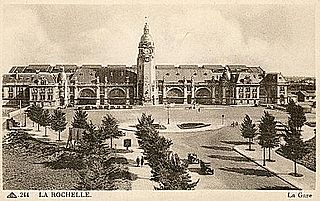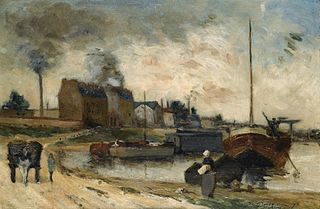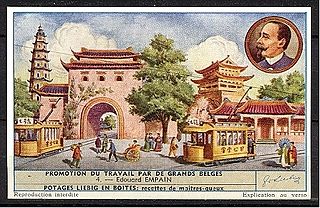

The Decauville factory in Moulins was used from 1918 to 1959 by the French railway supplier Decauville at Moulins, Allier.


The Decauville factory in Moulins was used from 1918 to 1959 by the French railway supplier Decauville at Moulins, Allier.
The factory belonged to the French company Société Nouvelle des Établissements Decauville Aîné and was located in the French Auvergne-Rhône-Alpes region of the département Allier. It was built in 1918 during World War I far from the front, to produce military material (tanks, shells), which it ultimately never did. Its main activities were the construction and maintenance of standard gauge wagons for the Compagnie des chemins de fer de Paris à Lyon et à la Méditerranée and Compagnie du chemin de fer de Paris à Orléans. They also made stationary steam engines. [2]
The plant was sold in 1959 during the economic crisis to Potain SA, a French manufacturer of tower cranes, which was finally taken over by Manitowoc Company in 2001. [3] [4]

The Ligne de Sceaux was a railway line in France running from Paris, which initially linked the Place Denfert-Rochereau (then called the Place d'Enfer, in Paris, to the town of Sceaux.

The Compagnie des chemins de fer de Paris à Lyon et à la Méditerranée, also known as the Chemins de fer Paris-Lyon-Méditerranée or simply PLM, established in 1857, was one of France’s main railway companies until the nationalization of all French railways and establishment of the Société nationale des chemins de fer français (SNCF) on 1 January 1938.

The Compagnie des chemins de fer de l'Est, often referred to simply as the Est company, was an early French railway company. The company was formed in 1853 by the merger of Compagnie du chemin de fer de Paris à Strasbourg, operating the Paris-Strasbourg line, and Compagnie du chemin de fer de Montereau à Troyes. In 1938 it became part of the majority state-owned Société Nationale des Chemins de fer Français (SNCF).

The Chemins de fer de l'État, often referred to in France as the Réseau de l'État, was an early state-owned French railway company.
The Compagnie des chemins de fer de l'Ouest, often referred to simply as L'Ouest or Ouest, was an early French railway company which operated from the years 1855 through 1909.

Émile Pereire and his brother Isaac Pereire were major figures in the development of France's finance and infrastructure during the Second French Empire. The Pereire brothers challenged the dominance of the Rothschilds in continental European finance, known at the time as haute finance. Their attempt was temporarily successful, and even though it collapsed in the late 1860s, it contributed to a more developed and vibrant economic landscape. Like the Rothschilds, the Pereires were Jews, but unlike them, they were Sephardi of Portuguese origin.

The Chemins de fer du Morbihan (CM) was a metre gauge railway in Morbihan, France, with some track in Loire-Inférieure. The first lines opened in 1902 and the system had a total extent of 433 kilometres (269 mi).

The Tramway de Pithiviers à Toury (TPT) was a 600 mm gauge railway in the Loiret department of France. It was built to carry sugar beet and was 80 kilometres (50 mi) long.
The Société Franco-Belge was a Franco-Belgian engineering firm that specialised in the construction of railway vehicles and their components and accessories. The company originated in 1859 as the Belgian firm Compagnie Belge pour la Construction de Machines et de Matériels de Chemins de Fer, founded by Charles Evrard. The company expanded its share capital in 1881 forming a new firm Société Anonyme Franco-Belge pour la Construction de Machines et de Matériel de Chemins de Fer and constructed a factory in Raismes (Valenciennes) in the Département Nord in France.
Rail transport in Morocco was initially developed during the protectorate. It functioned primarily as a means to mobilize colonial troops and to transport natural resources. Later, a standard-gauge network was built.

The railway from Moret-Veneux-les-Sablons to Lyon is a French 492-kilometre long railway line, that connects the Paris region to the city Lyon via Nevers and Saint-Étienne. The railway was opened in several stages between 1828 and 1861. The section between Saint-Étienne and Saint-Just-sur-Loire was the first railway line in France. It has functioned as an alternative line for the Paris–Marseille railway between Paris and Lyon. Its main use, besides local traffic, is now for the connection between Paris and Clermont-Ferrand.

The Compagnie du chemin de fer de Paris à Orléans (PO) was an early French railway company.
The Compagnie française de matériel de chemin de fer (CFMCF) was a French manufacturer of rail equipment, headquartered in Ivry-sur-Seine, with a factory in Maubeuge.
The French National Railways used to run a considerable number of 1,000 mmmetre gauge lines, a few of which still operate mostly in tourist areas, such as the St Gervais-Vallorcine (Alps) and the "Petit Train Jaune" in the Pyrenees. The original French scheme was that every sous-prefecture should be rail connected. Extensive 600 mm gauge lines were also built for the sugar-beet industry in the north often using ex-military equipment after the First World War. Decauville was a famous French manufacturer of industrial narrow-gauge railway equipment and equipped one of the most extensive regional 600 mm narrow-gauge railway, the Chemins de fer du Calvados. Corsica has a narrow-gauge network of two lines following the coast line, that are connected by one line crossing the island through highly mountainous terrain. The petit train d'Artouste, a tourist line in the Pyrenees, uses 500 mm gauge.

The Compagnie du chemin de fer Grand-Central de France, commonly known as the Compagnie du Grand-Central, or more simply the Grand-Central, was a railway company which operated in France from 1853 to 1857.

The Compagnie française des métaux (CFM) was a French metallurgy company founded in 1892 that acquired the assets of a predecessor that had gone into liquidation. The company operated a number of plants in different locations in France, mainly making copper and aluminum products. In 1962 it was merged with Tréfileries et Laminoirs du Havre to form Tréfimétaux.

The Société J.F Cail & Cie was founded in Paris on 6 June 1850 by Jean-François Cail (1804-1871). It was a French industrial company during the Second French Empire, whose activity was principally in sugar mills, railway locomotives and metal bridges.

The railway line between Pamiers and Limoux is a former French 63.1 km railway located in the departments of the Aude and Ariège. Built by the Compagnie des chemins de fer du Midi the line opened in two stages in 1898 and had its last section closed in 1973. The line branched from the Portet-Saint-Simon–Puigcerdà railway at Pamiers station and rejoined the Carcassonne–Rivesaltes railway at Limoux station.

The Empain group was a loose grouping of companies founded by Édouard Empain (1852–1929) of Belgium and controlled by the Empain family. From 1881 until merging with Schneider & Cie in 1969, the companies engaged in a broad range of activities including tramways, railways, electricity generation, construction and mining. The main areas of activity were Belgium and France, but the group also pursued opportunities in Russia, Egypt, China and elsewhere, and played a large role in the development of the eastern Belgian Congo.

The Tramways de Royan were two narrow-gauge railways that provided mainly passenger transport in and around the coastal resort town Royan in western France.